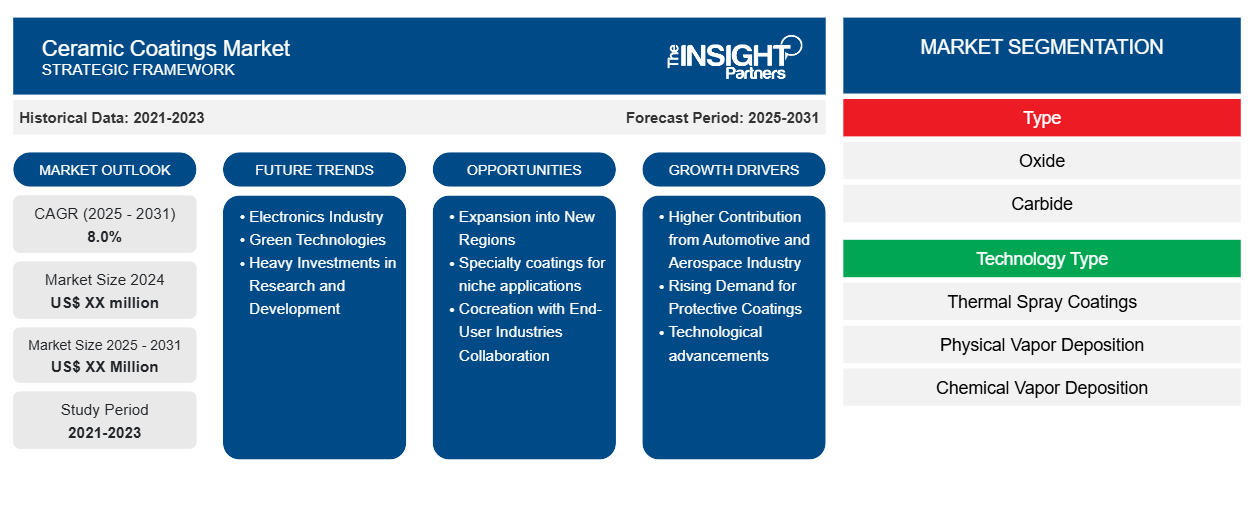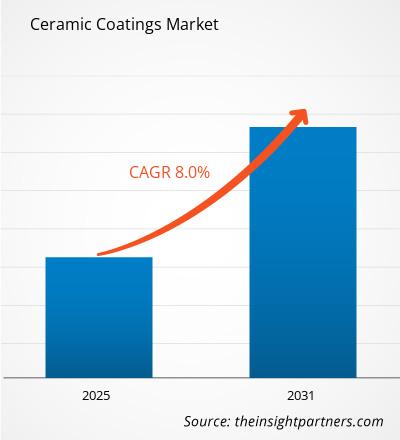The Ceramic Coatings Market is expected to register a CAGR of 8.0% from 2025 to 2031, with a market size expanding from US$ XX million in 2024 to US$ XX Million by 2031.
The ceramic coatings market is segmented into type, technology type, and end user. Based on type, the market is segmented into oxide, carbide, and others. Based on technology type, the market is segmented into thermal spray coatings, physical vapor deposition (PVD), chemical vapor deposition (CVD), and others. Based on end user, the market is segmented into automotive, aviation, industrial goods, medical, and others. The report scope covers five regions: North America, Europe, Asia Pacific, Middle East and Africa, and South and Central America and key countries under each region. The global analysis is further broken down at the regional level and major countries. The Report Offers the Value in USD for the above analysis and segments.
Purpose of the Report
The report Ceramic Coatings Market by The Insight Partners aims to describe the present landscape and future growth, top driving factors, challenges, and opportunities. This will provide insights to various business stakeholders, such as:
- Technology Providers/Manufacturers: To understand the evolving market dynamics and know the potential growth opportunities, enabling them to make informed strategic decisions.
- Investors: To conduct a comprehensive trend analysis regarding the market growth rate, market financial projections, and opportunities that exist across the value chain.
- Regulatory bodies: To regulate policies and police activities in the market with the aim of minimizing abuse, preserving investor trust and confidence, and upholding the integrity and stability of the market.
Ceramic Coatings Market Segmentation
Type
- Oxide
- Carbide
Technology Type
- Thermal Spray Coatings
- Physical Vapor Deposition
- Chemical Vapor Deposition
End User
- Automotive
- Aviation
- Industrial Goods
- Medical
Geography
- North America
- Europe
- Asia-Pacific
- Middle East and Africa
- South and Central America
You will get customization on any report - free of charge - including parts of this report, or country-level analysis, Excel Data pack, as well as avail great offers and discounts for start-ups & universities
Ceramic Coatings Market: Strategic Insights

-
Get Top Key Market Trends of this report.This FREE sample will include data analysis, ranging from market trends to estimates and forecasts.
Ceramic Coatings Market Growth Drivers
- Higher Contribution from Automotive and Aerospace Industry: Such coatings have a higher contribution from major sectors like automobile and aerospace. Such an industry demands high temperature-resistant materials that are corrosion-resistant and also low-friction. Hence, the ceramic coating material has high thermal stability, coupled with an excellent wear resistance ability and consequently optimal suitability for engines, turbines, and exhaust systems. Because these industries are constantly evolving and looking at improving fuel efficiency and performance, demand for high-performance ceramic coatings is going to increase in the near future.
- Rising Demand for Protective Coatings: More Demand in Applications across All Sectors is another factor that is pushing up demand for ceramic coatings. Ceramic coatings have gained popularity in oil and gas, chemical processing, and manufacturing sectors because they can safeguard equipment and surfaces from corrosion due to adverse environments. These coatings are highly resistant to chemicals, abrasion, and oxidation and are thus said to be very effective for extending the life of machinery and minimizing associated maintenance costs. It is also a consequence of rising asset protection awareness in industrial sites.
- Technological advancements: In terms of technological advances in methods of application of coatings, improvements in thermal spraying as well as sol-gel processes enhance performance while increasing the versatility of ceramic coatings. Such developments create more potential for improved adhesion, hardness, and flexibility in coatings. The growth of production has been promoted and directed toward relevant global sustainability goals through environmentally friendly coating solutions such as water-based and low-VOC formulations.
Ceramic Coatings Market Future Trends
- Electronics Industry: The industry also embraces insulation and protective ceramic coating very deeply. In circuit boards, semiconductors, and sensors, durability, and thermal resistance are of utmost importance. As the demand for even smaller and more energy-efficient electronic devices continues to rise, this industry will explode exponentially in terms of the requirement for its ceramic coatings.
- Green Technologies: Ceramic coating slowly, step by step in, gaining market shape by adopting more sustainability, which is very mainstream nowadays. This has been made possible due to environment-friendly coatings that make less impact on the ecosystem. Considerations in this include sustainable raw materials, processes reducing waste, and processes reducing energy usage. Customers have eagerly remained keen to consume products labeled with the green tag as such businesses are also compelled to find innovative and add ceramic coating solutions.
- Heavy Investments in Research and Development: Companies are putting a heavy investment into R&D to enhance the properties of ceramic coatings. They have developed them extensively to better fit an application range. Nanotechnology is also researched to improve coating performance and durability. It aims to make coatings capable of withstanding extreme conditions such as high temperatures and corrosive environments. In fact, this trend shows how the industry equips itself for the modern needs of the market.
Ceramic Coatings Market Opportunities
- Expansion into New Regions: Asian-Pacific, Latin American, and Middle Eastern countries are important emerging markets for the ceramic coatings market. Emerging economies, rapid industrialization, urbanization, and spending on infrastructure continue to drive the demand for protective coatings in such regions. Companies will find opportunities to expand manufacturing capacity or partnerships in such markets as a result of tapping local demand and new customers.
- Specialty coatings for niche applications: Specialty ceramic coatings are needed for specific applications, including biomedical implants, energy storage devices, and high-performance automotive parts. These can be the commercial foundation for the classes to be developed around these niches. Companies committed to innovative development-creation R&D for tailored application-specific coatings will position themselves to benefit from emerging market segments.
- Cocreation with End-User Industries Collaboration: Cocreation with End-User Industries Collaboration with key players in end-user industries can open up more growth avenues for the ceramic coatings market. Coating producers could enter into close collaboration with automotive, aerospace, and electronics firms to get an idea of the specific needs or concerns of that particular industry. Cocreation with these end-users leads to customized solution development-a value-added coating to enhance product performance and loyalty from the customer in that particular category.
Ceramic Coatings Market Regional Insights
The regional trends and factors influencing the Ceramic Coatings Market throughout the forecast period have been thoroughly explained by the analysts at The Insight Partners. This section also discusses Ceramic Coatings Market segments and geography across North America, Europe, Asia Pacific, Middle East and Africa, and South and Central America.
Ceramic Coatings Market Report Scope
| Report Attribute | Details |
|---|---|
| Market size in 2024 | US$ XX million |
| Market Size by 2031 | US$ XX Million |
| Global CAGR (2025 - 2031) | 8.0% |
| Historical Data | 2021-2023 |
| Forecast period | 2025-2031 |
| Segments Covered |
By Type
|
| Regions and Countries Covered |
North America
|
| Market leaders and key company profiles |
|
Ceramic Coatings Market Players Density: Understanding Its Impact on Business Dynamics
The Ceramic Coatings Market is growing rapidly, driven by increasing end-user demand due to factors such as evolving consumer preferences, technological advancements, and greater awareness of the product's benefits. As demand rises, businesses are expanding their offerings, innovating to meet consumer needs, and capitalizing on emerging trends, which further fuels market growth.

- Get the Ceramic Coatings Market top key players overview
Key Selling Points
- Comprehensive Coverage: The report comprehensively covers the analysis of products, services, types, and end users of the Ceramic Coatings Market, providing a holistic landscape.
- Expert Analysis: The report is compiled based on the in-depth understanding of industry experts and analysts.
- Up-to-date Information: The report assures business relevance due to its coverage of recent information and data trends.
- Customization Options: This report can be customized to cater to specific client requirements and suit the business strategies aptly.
The research report on the Ceramic Coatings Market can, therefore, help spearhead the trail of decoding and understanding the industry scenario and growth prospects. Although there can be a few valid concerns, the overall benefits of this report tend to outweigh the disadvantages.
Frequently Asked Questions
What is the furture trend for ceramic coatings market?
What are the deliverable formats of the ceramic coatings market?
Which regions are covered in the report?
What are the driving factors impacting the ceramic coatings market?
1. Increasing Demand from Automotive and Aerospace Industries
2. Rising Need for Protective Coatings
What are the key players operating in the ceramic coatings market?
What is the expected CAGR of the Ceramic Coatings Market?
- Historical Analysis (2 Years), Base Year, Forecast (7 Years) with CAGR
- PEST and SWOT Analysis
- Market Size Value / Volume - Global, Regional, Country
- Industry and Competitive Landscape
- Excel Dataset
Recent Reports
Related Reports
Testimonials
Reason to Buy
- Informed Decision-Making
- Understanding Market Dynamics
- Competitive Analysis
- Identifying Emerging Markets
- Customer Insights
- Market Forecasts
- Risk Mitigation
- Boosting Operational Efficiency
- Strategic Planning
- Investment Justification
- Tracking Industry Innovations
- Aligning with Regulatory Trends





















 Get Free Sample For
Get Free Sample For